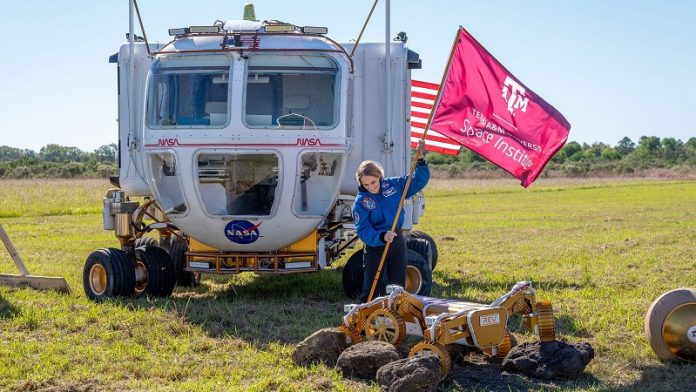
In the not-so-distant future, humans could be living and working on the Moon—and even Mars.
NASA’s Artemis missions are preparing for lunar bases by 2030 and a round trip to Mars in 2039. But building homes, labs, and workspaces in space presents a massive challenge.
Launching materials from Earth costs between $500,000 and $1 million per kilogram, making traditional construction methods impossible.
That’s where Dr. Patrick Suermann comes in.
A professor of construction science at Texas A&M University, Suermann is leading efforts to figure out how we can build in space using local materials, robotics, and advanced 3D-printing technologies.
With a background as a civil engineer and retired U.S. Air Force lieutenant colonel, he’s uniquely positioned to solve the big problems of off-world construction.
“Texas wants to be the space state,” Suermann says. “And Texas A&M is leading the way.” Working alongside NASA and the College of Engineering, Suermann’s team is developing construction methods for zero-gravity environments.
Their research is based at more than a dozen centers and labs at Texas A&M and will soon expand to NASA’s Johnson Space Center in Houston.
Construction in space must be efficient, waste-free, and safe.
By using robotics, autonomous systems, and materials like lunar regolith (the dusty soil covering the Moon’s surface), Suermann’s team is creating new building processes that may change not only how we construct things in space, but also how we build here on Earth.
For example, their work on 3D-printing lunar bricks could help build shelters in disaster zones or remote regions on our planet.
Suermann believes the lessons learned from space construction can make building on Earth cheaper, safer, and more sustainable. He compares the inefficiency of custom-built projects to the streamlined systems used in manufacturing.
“The more we can turn construction into manufacturing, the more efficient we’re going to be,” he explains.
His military experience, including building remote bases in places like Greenland, Antarctica, and Afghanistan, taught him how important it is to plan every detail in advance. In those locations, just like in space, there’s no running back to the store for a missing part.
Suermann’s love for space began early. As a child growing up near the Kennedy Space Center in Florida, he watched rocket launches from his backyard and built wooden bike ramps with scrap materials. He even wore a flight suit to visit the space center as a second-grader.
Now, he says, “I get to design with great minds in architecture and engineering, and I get to work with NASA. It really is my childhood dream come true.”
Looking ahead, Suermann is helping plan the 2026 Earth and Space Conference hosted by Texas A&M. It’s one of the world’s top events in aerospace and civil engineering—and he wants it to be the biggest ever.
As America moves toward becoming an interplanetary society, Suermann hopes the country will continue to invest in space research. “The penultimate version of remote construction is space,” he says. And thanks to people like him, we’re getting closer to building that future.



